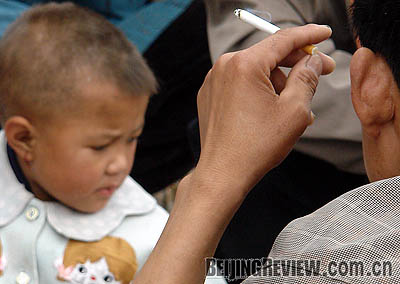|

PASSIVE POISONING: A child in a street in Zhengzhou, Henan Province, becomes an unconscious victim of secondhand smoke
SHA LANG
Only a stricter and wider ban on smoking in public places will rid China of the health burdens caused by tobacco
On the eve of the national publicity week for tumor prevention and control starting on April 14, Wu Yilong, Deputy Principal of Guangdong Provincial People's Hospital, revealed an inconvenient truth to the media: children and adolescents are increasingly becoming the victims of smoking induced cancers.
Wu told Guangzhou Daily that his hospital received three young lung cancer patients of around 20 in 2007, all diagnosed with senior stage cancer. Each of them was a non-smoker, but had been subject to an environment of frequent passive smoking. "Studies exhibit that it usually takes 15 years of being exposed to the pollution of smoke to developing cancer," Wu was quoted as saying. He said children were particularly sensitive to the cancer-causing agents in cigarette smoke as their bodies are still growing.
Beijing issued new rules in March to expand smoking restrictions from schools, sports arenas and movie theaters to bars, Internet cafes, hotels, offices, holiday resorts and all indoor areas of medical facilities from May 1. Besides being a move to meet China's pledge of a smoke-free Olympics, this new measure will hopefully reduce the kind of tragedies Wu has seen.
Secondhand smoke
China has 350 million smokers, the largest national smoker population in the world. Meanwhile, 540 million Chinese are victims of secondhand smoke, of whom 180 million are children under 15 years of age, according to the annual tobacco control report of the Ministry of Health for 2007.
Professor Li Yan of the Tumor Surgery Department of Zhongnan Hospital of Wuhan University said during an interview in April that tobacco smoke out of smokers' mouth with moisture was like an aerosol, more penetrating than smoke from lit tobacco. As an aerosol it attacks all the respiratory organs, including windpipes, bronchi and lung air sacs. Children's lungs have weaker mucous membrane, which makes them more vulnerable to poisoning from secondhand smoke.
According to figures on the occurrence of cancer in 2006 released by the Ministry of Health, lung cancer was the most deadly cancer for both Chinese men and women.
Zhou Huaqing, Principal of Tianjin Medical University General Hospital and a renowned lung cancer expert, said it is common knowledge within the international medical community that smoking is the most important cause of lung cancer and over 80 percent of lung cancer cases are related to smoking or passive smoking.
He said of the more than 5,000 chemicals in tobacco smoke, over 50 are cancer-causing agents, which could do more harm to passive smokers than to smokers themselves. He said the intensity of some cancer-causing agents in the smoke in the air from a lit cigarette is higher than that of smoke inhaled by smokers, such as nitrosamines.
The report also revealed that according to the national prevalence surveys on smoking from 1984, 1996 and 2002, although the numbers of smokers among the population was declining, there was no progress in passive smoking.
Zhejiang Provincial Center for Disease Control and Prevention released a survey on smoking in 2007, which indicated that one of every three middle school students was an active or passive smoker at school and over half of middle school students were active or passive smokers at home.
Starting young
A survey by Jiangsu Provincial Center for Disease Control and Prevention last year was conducted on 1,302 students, including 731 males and 571 females, with 949 of the students less than 18 years old. The researchers found that 21.1 percent of the respondents had tried smoking, 24 percent among male respondents and 6.3 percent among female respondents, and 6 percent has bought cigarettes in the last month. Among those who had started smoking, 24 percent had tried smoking before the age of seven.
Statistics from the Ministry of Health indicate that Chinese smokers are starting younger. Compared with 1984, the average starting age of Chinese smokers in 2002 had dropped by four to five years, to 18 for males and 20 for females. The national prevalence surveys on smoking of 1984, 1996 and 2002 showed that the population of adolescent smokers had expanded to at least 50 million.
Yan Jie, an expert on children's tumors at Tianjin Medical University Cancer Institute and Hospital, told Tianjin Daily in April that children became smokers mainly due to their surrounding environment. Yan said children have stronger curiosity toward new things than adults and like imitating what adults do. Therefore, children often smoke at first by imitating adult smokers around them and smokers on television; they smoke for fun and the rebellious air in the beginning and gradually get addicted and become heavy smokers.
| 